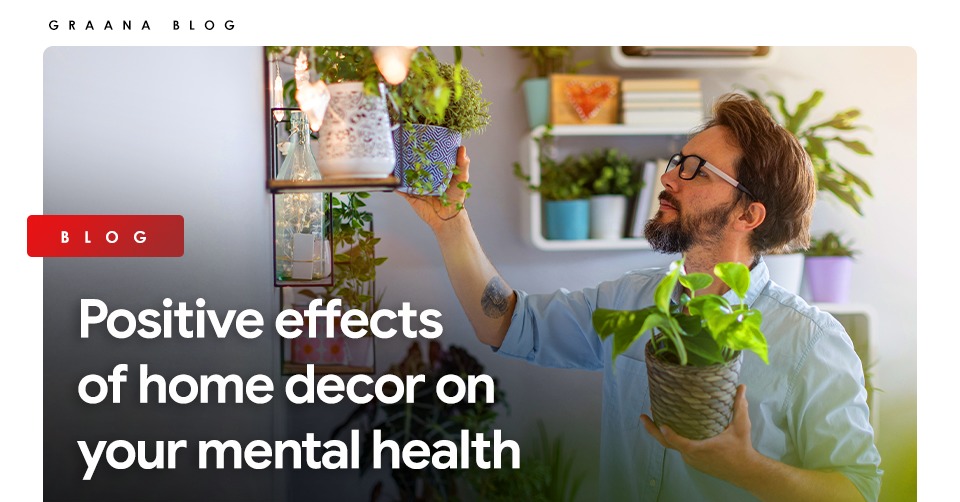
A healthy and beautiful environment is essential for good mental health. If your house isn’t in good shape, it will impact you, and you will end up feeling chaotic and perplexed. This can result in irritability, despair, and a lack of productivity.
Subtle yet pervasive elements, such as the height of the ceilings and the presence of plants, can elevate mood, promote concentration, and reduce anxiety. Environments that enhance productivity, intimacy, and efficiency are instinctively appealing to humans.
Graana.com brings you a list of things that can make your environment good for your mental health.
It is preferable to have fewer unnecessary goods. Decluttering reduces dust, trip hazards, and the amount of time you spend cleaning. Being in a de-cluttered environment simply makes you feel more cognitively transparent. Clutter has been shown to deplete energy and have a detrimental impact on our general mood and self-image. Start by decluttering your space to get clarity.
One of the fundamental components of happier settings appears to be a sense of spaciousness. According to a study, people are more creative, and their mood improves when they are in rooms with higher ceilings. The benefits of spaciousness can, nevertheless, be attained in rooms with lower ceilings. Clean and spacious homes with minimal clutter facilitate improved moods. This sense of openness can be achieved in almost any space with the right design, furniture, organisation, and lighting.
Natural light seems to make people feel better. Natural light helps maintain our internal body clocks in sync, such as our sleep-wake cycles, which are reset when exposed to it. Daylight improves attentiveness, and students in rooms with natural illumination scored 10% higher on examinations in one research. Sunlight gives visual cues to your brain, which aid in the regulation of your circadian cycle. According to one analysis, people working in offices with windows slept 46 minutes longer per night than those under artificial lights. Even patients in hospitals with windows that face trees take fewer pain medications and recover faster than those with windows that face brick walls.
Allowing some natural light into the room is essential for constructing a setting for healthy mental health. Plant life offers significant psychological benefits, as it reduces agitation, stress and improves focus. Plants have also been connected to speedier healing times, as well as enhanced communication and compassion. Flowers can also help to improve one’s mood. Flowers can help to alleviate depression and improve pleasant sensations in the house. Flowers not only are a lovely compliment to the aesthetic of any environment, but they have a calming, relaxing effect on people and make them feel happier.
Colour is one of the most well-known mood-altering design aspects. Colour is an essential part of many people’s world experiences. Reds, yellows, and oranges are referred to as “warm colours,” whereas greens, blues, and purples are “cool colours.” These classifications aren’t coincidental. We feel physiologically warmer when we are in rooms with warm colours. Colours that are excellent help us feel calmer. That’s why reds are so popular in the winter, whilst turquoise and teal are more prevalent in the summer. Each colour, of course, has psychological implications. Years of studies confirm that some colours consistently evoke specific emotional responses.
Add colours in your space that match your emotional needs. Even a tiny inclusion of colour in an area can enhance the overall feel of the environment. Research before opting for any colour can make a significant difference.
The sight of bare walls might be gloomy. If your walls are feeling bare, consider adding a few patterns that will brighten your day. Finding a look that speaks to you and makes you happy is subjective, so choose something that speaks to you and makes you happy. Don’t stop at the walls, either. Consider incorporating other ornamental art elements. E.g a miniature sculpture or a lovely vase. To bring you delight, art does not have to be large or expensive. Look for pieces that speak to you and are appropriate for how you live and want to feel in your home.
In a nutshell, your home should be where you feel the most comfortable and can be yourself.
ISLAMABAD: The Capital Development Authority (CDA) and the Asian Development Bank (ADB) have entered into…
Islamabad: The Capital Development Authority (CDA) has announced plans to issue possession letters to allottees…
Islamabad, [24 March 2025] – Graana.com, Pakistan's leading online real estate marketplace, is proud to…
Islamabad, Pakistan – March 2025: Graana.com, Pakistan’s leading real estate platform, has proudly partnered with…
KARACHI: Sindh Local Government Minister Saeed Ghani chaired a meeting on Monday to review measures…
ISLAMABAD: The Capital Development Authority (CDA) has unveiled plans to develop a modern food street…